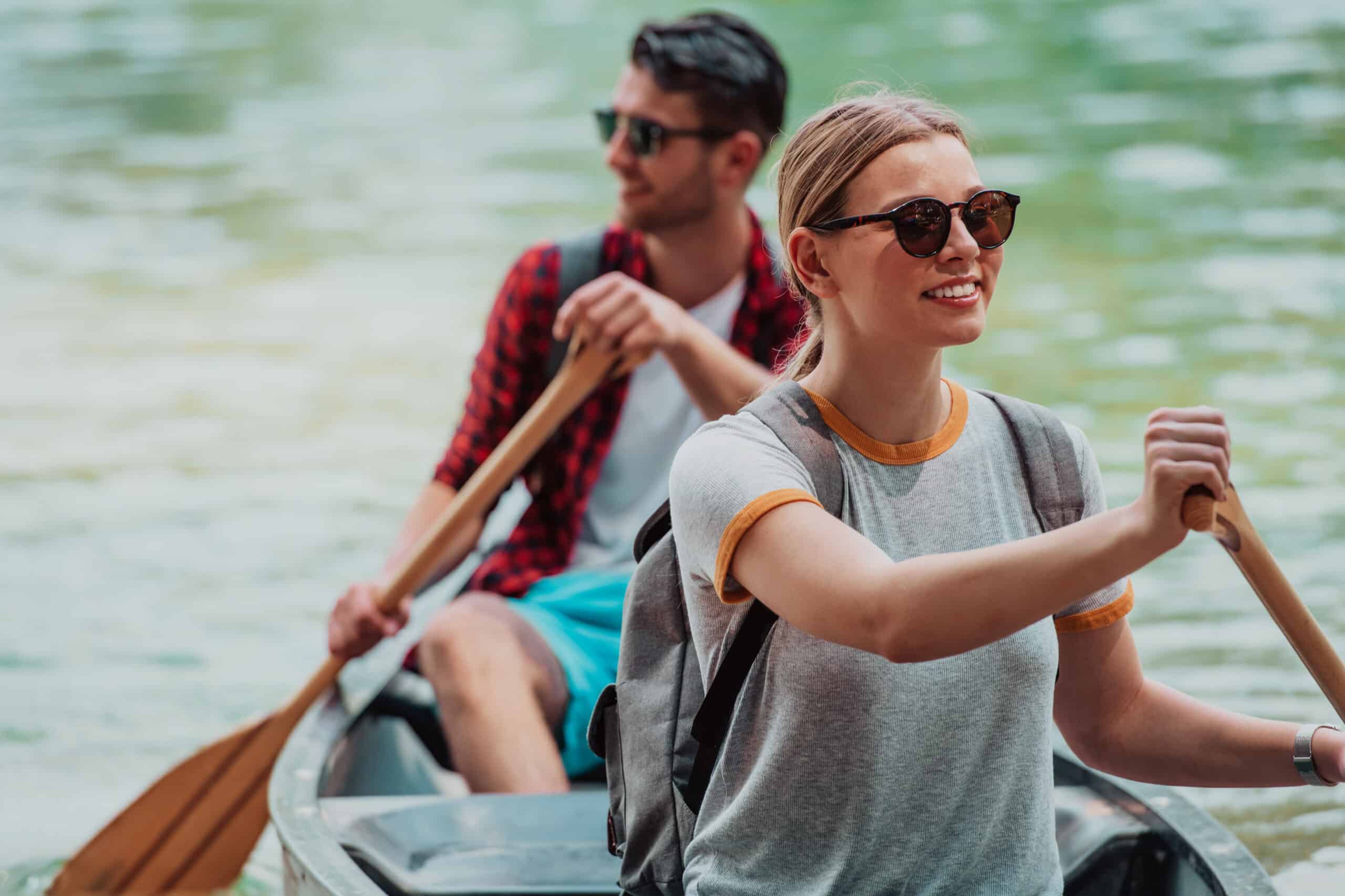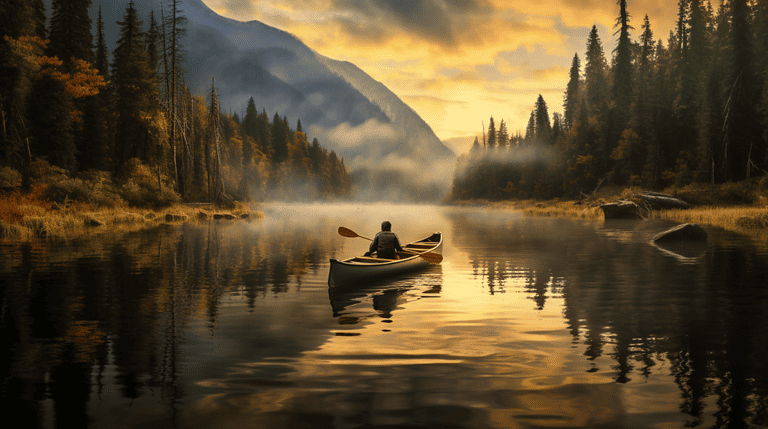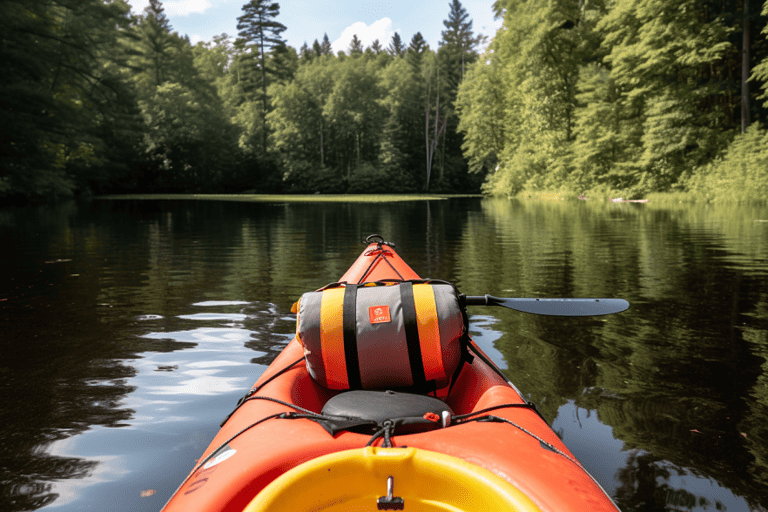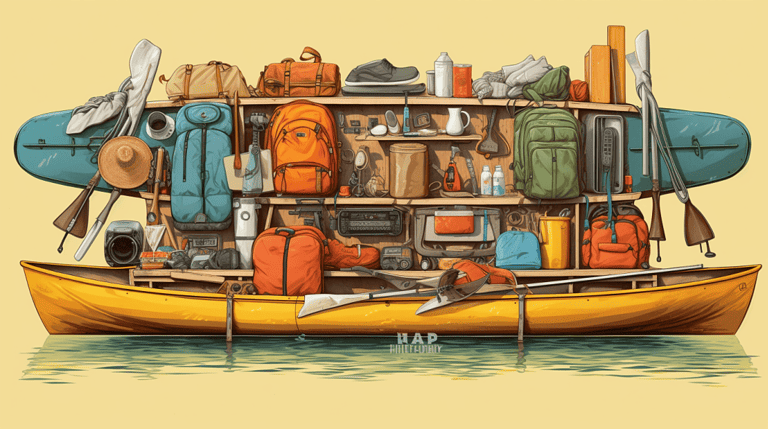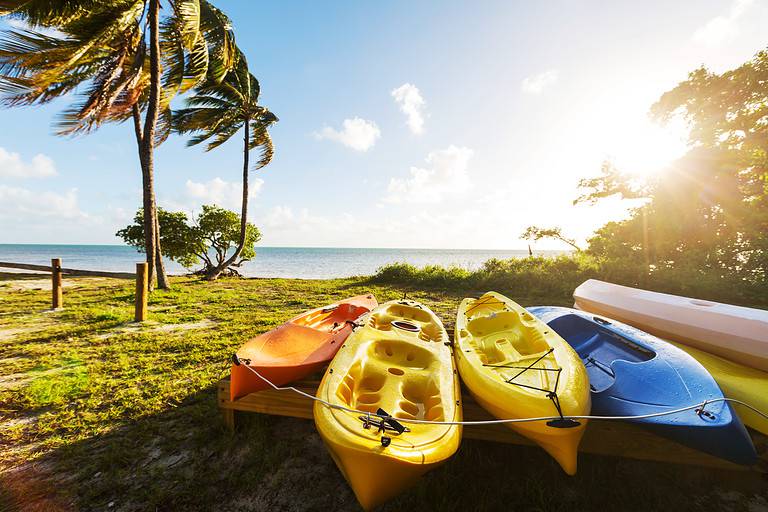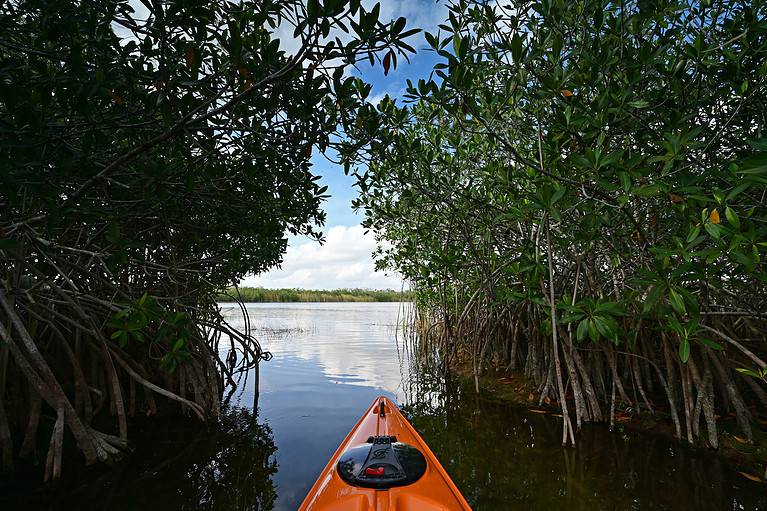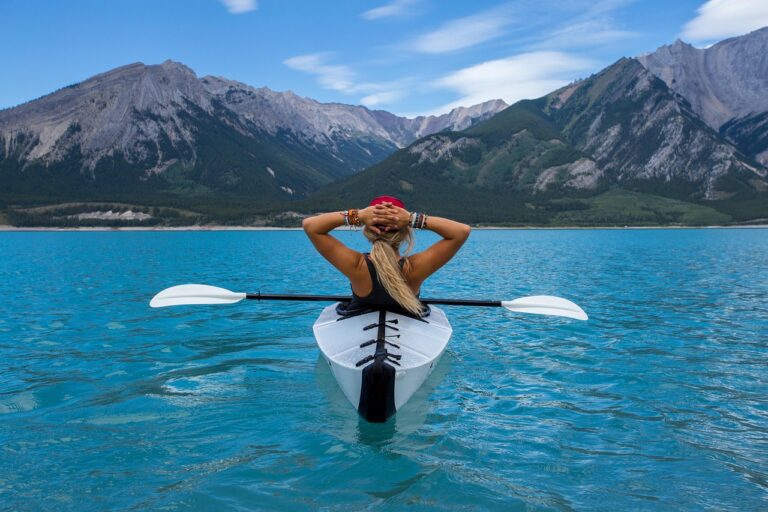Canoeing in the USA: Serenity & Adventure on Stunning Waterways!
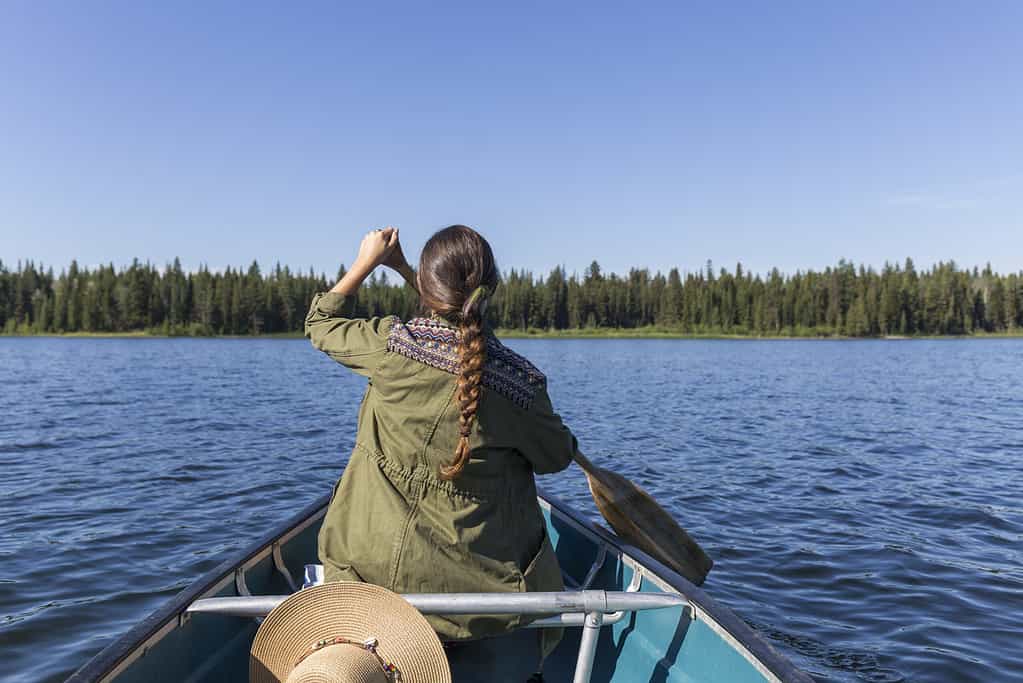
Canoeing in the USA is a breathtakingly beautiful activity that allows you to explore the country’s stunning waterways. From calm lakes and rivers to wild rapids, various destinations cater to different skill levels and preferences. Whether you are a seasoned paddler or a beginner, canoeing in the USA is an experience that will leave you mesmerized.
Canoeing allows you to escape from bustling city life and immerse yourself in nature’s tranquility. The sound of your paddle dipping into the water, birds chirping, and leaves rustling in the wind create an atmosphere of serenity that rejuvenates your mind and soul. Moreover, it provides ample opportunities for wildlife sightings, fishing, camping on secluded islands, and much more. So pack your bags and head out on an exciting adventure exploring America’s picturesque waterways!
Key Takeaways
- Canoeing in the USA offers diverse destinations for different skill levels and preferences, allowing for an escape from city life and immersion in nature’s tranquility.
- Safety precautions, including proper gear, understanding weather conditions and water levels, navigation and map reading, and basic first aid techniques, are crucial for a successful and stress-free canoe trip.
- Mastering paddling techniques and skills, observing and conserving wildlife, and practicing leave-no-trace principles are important for appreciating the natural beauty of the outdoors and protecting it for future generations.
- Researching and budgeting for transportation costs and planning the itinerary based on waterways and terrain in different regions of the USA are important for a successful canoe trip.
Choosing the Right Destination
When planning your canoeing adventure in the USA, choosing the right destination that fits your experience level and desired scenery is important. Do you want a leisurely paddle down a calm river surrounded by stunning mountain views? Or are you seeking a more challenging expedition through rapids and gorges? Research different locations and their offerings, including canoe rental options and guided tours.
Consider factors such as water conditions, weather patterns, and accessibility. Some popular destinations for canoeing include the Boundary Waters Canoe Area Wilderness in Minnesota, the Ozarks in Arkansas, and the Everglades in Florida. Once you’ve chosen your destination, it’s time to acquire the necessary gear to ensure a safe and enjoyable trip.
Acquiring the Necessary Gear
You’ll love how easy it is to get all the gear you need for your upcoming adventure on the water. Whether you plan on exploring calm lakes or taking on rapids, there are a few things that you should consider before making your purchase. Here are some tips to guide you through buying vs renting and essential accessories for canoeing in the USA:
- Buying vs. Renting: If you’re planning more than one trip, buying your canoe will save time and money in the long run. However, renting may be a better option if this is a one-time event or you’re unsure about owning a canoe.
- Essential Accessories: Paddles, life jackets, and helmets are mandatory when paddling in any body of water. Additionally, consider purchasing dry bags for personal items that must stay dry during travel.
Understanding safety precautions is crucial before embarking on any outdoor activity involving water sports. With your necessary gear acquired or rented out, let’s dive into understanding safety precautions for an enjoyable experience on the water!
Understanding Safety Precautions
Before you hit the water, it’s crucial to understand safety precautions for canoeing. Weather conditions and water levels can change quickly, so be sure to check forecasts and plan accordingly. Navigation and map reading are also essential skills to have, as getting lost on the water can be dangerous. Lastly, know emergency procedures and first aid in case of an accident or injury. By being prepared with these key points, you’ll be able to enjoy your canoeing experience while staying safe.
Weather Conditions and Water Levels
Despite occasional fluctuations, weather conditions and water levels can greatly impact the overall experience of canoeing in the USA. Here are four factors to consider when planning your trip:
- Water temperature: Depending on your location, water temperatures can vary greatly. The water may be too cold in some regions for comfortable paddling without proper gear. On the other hand, in warmer areas, high water temperatures can lead to dehydration and sunburn.
- River flow: The flow of a river can make or break your canoeing experience. High-flow rivers offer a thrilling ride with rapids and waves that challenge even experienced paddlers. However, low-flow rivers may require more portaging and have less excitement.
- Impact of climate change: With changing weather patterns due to climate change, it’s important to keep an eye on any changes in precipitation levels or extreme weather events that could affect your safety while canoeing.
- Flood warnings: Even if everything else seems perfect for canoeing, always check for flood warnings before heading out on the water. Heavy rainfall can cause flash flooding that creates dangerous conditions for paddlers.
Considering these factors will help ensure a safe and enjoyable experience while canoeing in the USA. As you plan your trip, keep navigation and map reading in mind as it is equally important to stay on course during your adventure on the waterways of America!
Navigating through waterways can be a challenging but rewarding experience, with studies showing that individuals who use maps have a higher chance of successfully completing their journey. When it comes to map reading, there are different tools and skills that come into play. Some people prefer using compasses for navigation, while others rely on GPS technology. Topographical maps can also be useful for land-based canoe trips where elevation changes must be considered, while nautical charts are essential for navigating waters with varying depths and hazards.
In addition to orienteering skills and the use of navigational aids such as landmarks or buoys, it’s important to keep an eye out for changing weather conditions and water levels. These factors can make a significant impact on your journey and affect your ability to navigate safely. As you paddle along the waterways of the USA, take some time to familiarize yourself with the local area by studying maps and noting key reference points along your route. With proper preparation and attention to detail, you’ll be able to enjoy your trip while minimizing risks along the way.
Transitioning into emergency procedures and first aid: While navigation is an essential aspect of any canoe trip, it’s equally important to prepare for potential emergencies that may arise during your journey. By familiarizing yourself with basic first aid techniques and carrying appropriate safety equipment such as life jackets or flares, you’ll be better equipped to handle unexpected situations should they arise.
Emergency Procedures and First Aid
Now that you know how to navigate and read maps while canoeing in the USA, it’s important to be prepared for any emergency situation. Whether you’re on a day trip or a multi-day expedition, accidents can happen. That’s why it’s crucial to understand proper emergency procedures and first aid.
Some of the most common emergencies on the water include choking hazards, snake bites, sunstroke, and hypothermia. Knowing how to prevent and treat these situations could mean the difference between life and death. In the table below, we’ve outlined some key tips for handling these emergencies:
| Emergency | Procedure | First Aid |
| Choking hazards | Perform Heimlich maneuver | Check airway and provide rescue breaths |
| Snake bites | Keep victim calm and still | Clean wound with soap and water |
| Sunstroke | Move victim to cool area, give fluids | Apply cool compresses or immerse in cool water |
| Hypothermia | Move victim indoors if possible, warm up gradually | Remove wet clothing, wrap in blankets |
Remember that prevention is always better than treatment. Be sure to pack appropriate gear for your trip including sunscreen, hats or visors for sun protection as well as warm layers for colder weather. By preparing adequately and knowing what to do in an emergency situation, you’ll be able to enjoy your canoeing adventure safely.
As you plan your itinerary for canoeing in the USA, keep in mind the importance of being prepared for emergencies. Now that you know how to handle potential crises such as choking hazards or snake bites using proper procedures and first aid techniques like those detailed above (in our table), you can focus on planning your route without worrying about unexpected incidents along the way.
Planning Your Itinerary
When planning your itinerary, you’ll want to consider the various waterways and terrain available in different regions of the USA. Seasonal considerations should also be considered, as different areas will have varying weather conditions. For example, if you plan on canoeing in Alaska or the Pacific Northwest during winter, pack for extreme cold temperatures and snowfall. On the other hand, summer months in the southern states can bring high humidity and thunderstorms.
Budgeting constraints are another important factor to consider when planning your canoe trip. Some areas may require permits or fees for access to certain waterways or campsites. Additionally, transportation costs, such as renting a vehicle or paying for shuttle services, can add up quickly. Researching and budgeting is important to ensure a successful and stress-free trip.
As you prepare for your adventure on the water, remember these tips for a successful canoe trip…
Tips for a Successful Canoe Trip
If you want to have a successful canoe trip, there are some important skills and techniques that you should learn. Paddling may seem simple at first, but mastering different strokes and maneuvers will make your journey smoother and more enjoyable. You’ll also want to keep an eye out for wildlife along the way – observing animals in their natural habitat can be a highlight of any trip! But while enjoying nature, it’s important to practice Leave No Trace principles and be mindful of sustainability practices to minimize your impact on the environment.
Paddling Techniques and Skills
Mastering paddling techniques and skills is essential for any canoeist as it not only ensures safety but also enhances your overall experience. Stroke techniques are the foundation of efficient and effective paddling. The most common strokes include the forward stroke, backward stroke, J-stroke, draw stroke, and sweep stroke. Each of these strokes serves a specific purpose and can be used in different situations. Proper execution of these strokes requires body positioning and coordination.
Body positioning plays a crucial role in maintaining balance and stability in the canoe. To achieve proper body positioning, sit up straight with your feet flat on the bottom of the boat, keeping your knees slightly bent to absorb shock from waves or rapids. Keep your eyes focused on where you want to go rather than looking down at your paddle or feet. With practice, mastering these fundamental techniques will help you become a skilled canoeist ready to tackle any adventure that comes your way.
As you navigate through various bodies of water during your canoe trip, observing wildlife becomes an exciting activity worth indulging in without causing harm to animals or their environment.
Wildlife Observation and Conservation
Observing and conserving wildlife is a crucial aspect of any canoe trip, as it allows you to appreciate the natural beauty around you and protect it for future generations. Here are four tips to help you observe and conserve wildlife during your next canoe trip:
- Keep your distance: It’s important to keep a safe distance from wildlife to avoid disturbing them. This also ensures your safety since some animals may become aggressive if they feel threatened.
- Use binoculars or a camera with zoom lens: Instead of getting too close, use binoculars or a camera with zoom lens for better observation without disturbing the animals.
- Practice responsible photography: Wildlife photography can be amazing but make sure not to cause any environmental impact while doing so. Avoid using flash when taking pictures as it can startle animals, and never get too close just for a perfect shot.
- Leave no trace: Always remember to leave no trace behind after observing and enjoying wildlife during your canoe trip. This means packing out all trash, avoiding damaging vegetation and rock formations, and minimizing human impact in general.
As we strive to enjoy our natural surroundings responsibly, understanding leave-no-trace principles is essential – these will ensure that our actions have minimal environmental impact while still allowing us to enjoy the great outdoors fully!
Leave No Trace Principles and Sustainability
You can make a positive impact on the environment during your next camping or hiking trip by following Leave No Trace principles and practicing sustainability. These principles include minimizing campfire impact, disposing of waste properly, staying on designated trails, respecting wildlife, and leaving what you find untouched. By following these simple guidelines, you can help reduce waste and promote ethical camping practices.
Reducing waste is an important aspect of sustainable camping. Bring reusable water bottles and containers instead of disposable ones. Avoid using single-use plastics like straws and utensils by bringing your own reusable alternatives. Properly dispose of all waste in designated trash and recycling bins or pack it out with you if there are no facilities available. By taking small steps to reduce your environmental impact while enjoying the great outdoors, you can help preserve our natural resources for future generations to enjoy.
Conclusion
Congratulations! You are now ready to embark on your canoeing adventure in the USA. With the right destination, gear, safety precautions, and itinerary planning, your trip is sure to be a success. Remember to always be aware of your surroundings and follow any rules or regulations set forth by the area you are exploring.
As you paddle through calm waters or navigate rapids, take a moment to appreciate the beauty of nature around you. The sound of water rushing beneath your canoe and the sight of wildlife in their natural habitat will leave an impression that lasts long after your trip has ended. So pack up your gear and get ready for an unforgettable experience!
Using repetition as a rhetorical device can add emphasis and make the writing more engaging. By repeating key phrases such as “the right destination,” “gear,” “safety precautions,” and “itinerary planning,” it reinforces their importance in ensuring a successful canoeing trip. This technique creates a rhythm that draws in the reader while emphasizing crucial information. So remember: choose wisely, prepare properly, stay safe, plan ahead, and enjoy all that canoeing in the USA has to offer!

